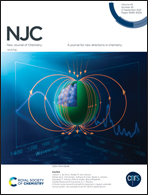Proposing high-affinity inhibitors from Glycyrrhiza glabra L. against SARS-CoV-2 infection: virtual screening and computational analysis†
Abstract
Severe acute respiratory syndrome coronavirus 2 (SARS-CoV-2) has caused a global outbreak of respiratory infection with high mortality. Licorice (Glycyrrhiza glabra L. or G. uralensis Fisch.) is one of the recommendations of different traditional medicines for the management of patient symptoms. Herein, the in silico interaction of main licorice components against SARS-CoV-2 infection was assessed in order to introduce promising antiviral phytochemicals. A set of 56 licorice compounds was subjected to high throughput virtual ligand screening using the spike receptor-binding domain, main protease, papain-like protease, RNA-dependent RNA polymerase, or endoribonuclease non-structural protein, as well as human angiotensin-converting enzyme 2, as antiviral targets. The structure–activity relationship (SAR) based on the docking energy, along with absorption, distribution, metabolism, excretion, and toxicity (ADMET) parameters, was considered for the selection of the most suitable compounds. Six licorice components, including two triterpenoids (glycyrrhizic acid and licorice saponin C2) and four flavonoids (liquiritin apioside, glucoliquiritin apioside, glucoliquiritin, and glyasperin A), were finally obtained as acceptable ligands. All-atom molecular dynamics (MD) simulations along with the results of binding free energy confirmed the stable fitting of the screened compounds into the active site of the selected targets, suggesting glycyrrhizic acid to have the highest affinity to all targets. Moreover, the binding mode and the key amino acids interacting with the licorice compounds in each target after the MD simulation were considered. The results suggest licorice as a promising substance to be further investigated in experimental models in SARS-CoV-2 infection, showing its therapeutic effect to be, at least in part, due to antiviral properties. Glycyrrhizic acid, already considered as a licorice major active ingredient, seems to have a significant role in antiviral effects. Future experimental studies are recommended to confirm the safety and efficacy of licorice in SARS-CoV-2 infection.



 Please wait while we load your content...
Please wait while we load your content...